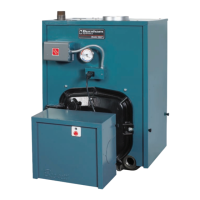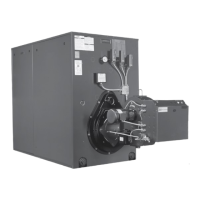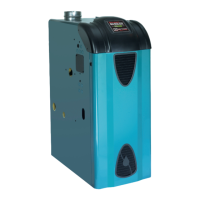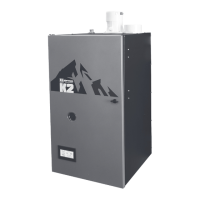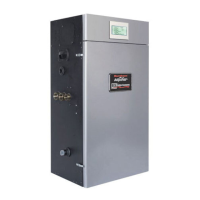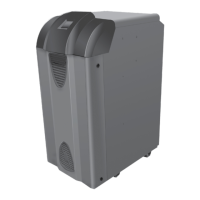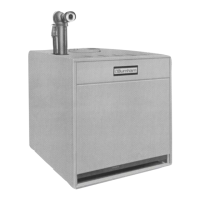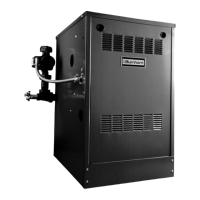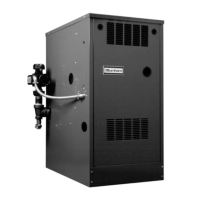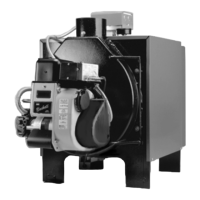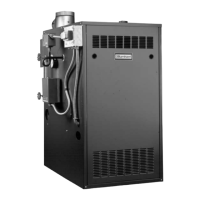50
F. BOILER AND SYSTEM CLEANING - WATER
BOILERS
1. Filling of Boiler and System --- General --- In a hot
water heating system, the boiler and entire system
(other than the expansion tank) must be full of water
for satisfactory operation. Water should be added to
the system until the boiler pressure gauge registers
normal system design operating pressure. To insure
that the system is full, water should come out of all
air vents when opened.
2. Boiling Out of Boiler and System. The oil and
grease which accumulate in a new hot water boiler
can be washed out in the following manner.
a. Remove safety relief valve using extreme care
to avoid damaging it.
b. Add an appropriate amount of recommended
boilout compound.
c. Reinstall safety relief valve.
d. Fill the entire system with water.
e. Start ring the boiler.
f. Circulate the water through the entire system.
g. Vent the system, including the radiation.
h. Allow boiler water to reach operating
temperature, if possible.
i. Continue to circulate the water for a few hours.
j. Stop ring the boiler.
k. Drain the system in a manner and to a location
that hot water can be discharged with safety.
l. Remove plugs from all available returns and
wash the water side of the boiler as thoroughly
as possible, using a high-pressure water stream.
m. Rell the system with fresh water.
3. Add appropriate boiler water treatment compounds
as recommended by your local qualied water
treatment company.
4. Make pH or Alkalinity Test.
After boiler and system have been cleaned and
relled as previously described, test the pH of the
water in the system. This can easily be done by
drawing a small sample of boiler water and testing
with hydrion paper which is used in the same
manner as litmus paper, except it gives specic
readings. A color chart on the side of the small
hydrion dispenser gives the reading in pH. Hydrion
paper is inexpensive and obtainable from any
chemical supply house or thru your local druggist.
The pH should be higher than 8.3 but lower than
10.5. Add some appropriate water treatment
chemicals, if necessary to bring the pH within the
specied range. With this lower level of protection,
care must be exercised to eliminate all of the free
oxygen in the system.
5. Boiler is now ready to be put into service.
IF, DURING NORMAL OPERATION, IT IS NECESSARY
TO ADD MORE WATER PER MONTH THAN INDICATED
BELOW, CONSULT A QUALIFIED SERVICE TECHNICIAN
TO CHECK YOUR SYSTEM FOR LEAKS.
EXCESSIVE WATER ADDITION:
(Gal/Month)
V903A 16½ V908A 44
V904A 22 V909A 49½
V905A 27½ V910A 55
V906A 33 V911A 60½
V907A 38½ V912A 66
SI, PENDANT LE FONCTIONNEMENT NORMAL, IL EST
NÉCESSAIRE D’AJOUTER PLUS D’EAU PAR MOIS QUE
CE QUI EST INDIQUÉ CI-DESSOUS, CONSULTEZ UN
TECHNICIEN DE SERVICE QUALIFIÉ POUR VÉRIFIER
L’ÉTABLISSEMENT DES FUITES DE VOTRE SYSTÈME.
AJOUT D’EAU EXCESSIF:
(Gal / Mois)
V903A 16½ V908A 44
V904A 22 V909A 49½
V905A 27½ V910A 55
V906A 33 V911A 60½
V907A 38½ V912A 66
H. FREQUENT WATER ADDITION
A leaky system will increase the volume of make-up
water supplied to the boiler which can signicantly
shorten the life of the boiler. Entrained in make-up
water are dissolved minerals and oxygen. When the
fresh, cool make-up water is heated in the boiler the
minerals fall out as sediment and the oxygen escapes
as a gas. Both can result in reduced boiler life. The
accumulation of sediment can eventually isolate
the water from contacting the cast iron. When this
happens the cast iron in that area gets extremely hot
and eventually cracks. The presence of free oxygen
in the boiler creates a corrosive atmosphere which, if
the concentration becomes high enough, can corrode
the cast iron through from the inside. Since neither of
these failure types are the result of a casting defect, the
warranty does not apply. The maintenance of system
integrity is the best method to prevent these types of
failure.
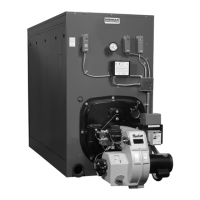
